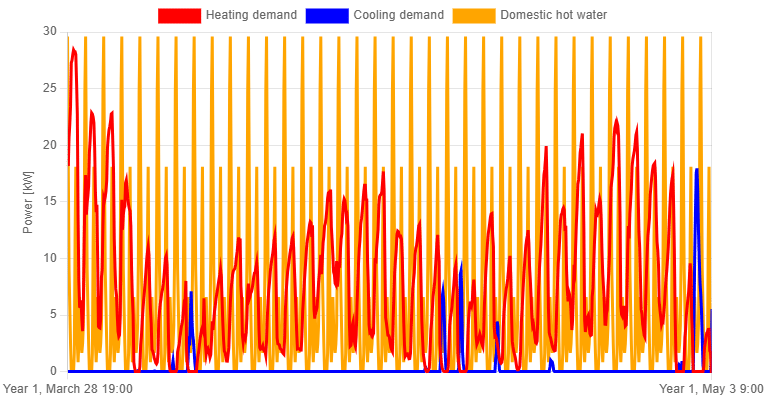With buildings becoming increasingly well insulated, domestic hot water demand is becoming more important when designing geothermal borefields. In this article we introduce the new option in GHEtool Cloud to work with hourly domestic hot water profiles.
Domestic hot water in GHEtool
In geothermal design there are two important aspects: the long term effect, governed by the geothermal imbalance, and the short term effect, which is governed by the peak power on the borefield.
The domestic hot water (DHW) demand influences the imbalance quite significantly, especially now that insulation standards are increasing and the extraction demand is increasingly dominated by the demand for domestic hot water. However, since the imbalance is only important over the long time scale (as explained in our article hier), the peak power of the domestic hot water is not that important. That is why in the past you would enter the domestic hot water as a yearly energy demand, assuming it was produced constantly at a certain baseload power.
For certain building types such as hotels, spas and swimming pools, this assumption is not very accurate, since they can have very pronounced tap water profiles. Hotels, for example, will experience a high peak demand in DHW in the morning and again in the evening before dinner. Therefore, in this case it is not unreasonable that the capacity of the heat pump is selected to cope with this high domestic hot water peak demand and that it also has an influence on the short term behaviour of the borefield (as explained hier).
In the example below, a close up is shown from the hourly load profile where you can clearly see that the demand for DHW is greater than the demand for heating.

Compatibility with existing methods
How does this new hourly (yearly and multi yearly) DHW profile work together with the existing methods in GHEtool Cloud?
For all methods related to the simulation and calculation of the temperature profile (calculate temperature profile, calculate required depth, combine active and passive cooling, and so on) there is direct support for working with hourly DHW profiles. However, when you want to simulate hybrid systems, there are some important points to note.
Optimise for power and balance
Both the optimise for power (read more hier) and optimise for balance (more information in this article) methods have been adapted to work with this new load profile. As you might recall from our previous articles, both methods lowered the peak heating demand in such a way that the minimum average fluid temperature remained within the temperature limits. However, now that both heating and domestic hot water demand contribute to the extraction load, a choice has to be made as to which load is limited first.
At the moment, these methodologies favour the production of DHW over the production of heating using the ground source heat pump. This means that whenever the minimum average fluid temperature falls below the threshold, the peak heating demand is reduced first. Only when, in extremis, all the heating is removed from the borefield will the DHW demand be lowered.
!Stay tuned
We continue to work on improving the speed of these methods. In a future update you as a user will have the choice to select which demand you want to limit first.
In the example below (for the optimise for power method) you can clearly see that the heating demand is limited, whereas the domestic hot water profile is still being delivered one hundred per cent by the borefield.

In the load duration curve this becomes even more visible. The resulting geothermal power for heating that can be supplied by the borefield is 14 kW, whereas for domestic hot water it is 30 kW.

Simulate hybrid system and optimise for energy
When you are simulating your hybrid system or optimising for energy, the methodologies assume that your DHW demand will always be fulfilled by the geothermal borefield.
The simulate hybrid system method (which you can read more about hier) assumes that the switch between the different technologies in your hybrid system occurs based on a temperature threshold of the outside temperature. Since DHW demand typically does not depend on the outside temperature, it is assumed to be always delivered by the ground source heat pump.
For the optimise for energy method, it is not yet feasible to optimise both heating and DHW as is the case with the other optimisation methods. In the backend, the optimise for energy method converts the load to a monthly load profile (for more information on the methodology, see this article). On a monthly time scale it is not possible to distinguish between heating and DHW load. Therefore, when working with the optimise for energy method, the DHW load will not be optimised and will be assumed to be fully delivered by the ground source heat pump.
Fazit
Domestic hot water demand is becoming increasingly important in geothermal design. This is especially true for buildings with pronounced tap water profiles, such as hotels, hospitals or swimming pools. In such cases this load not only influences the geothermal imbalance but also the short term behaviour.
In this article the new option to work with hourly DHW profiles was introduced, showing both how straightforward it is and how it integrates with existing methods. The implementation of hourly profiles for DHW is the first step towards making hybridisation, and soon regeneration methods, more flexible.
Literaturverzeichnis
-
- Sehen Sie sich unsere Videoerklärung auf unserer YouTube-Seite an, indem Sie klicken hier.